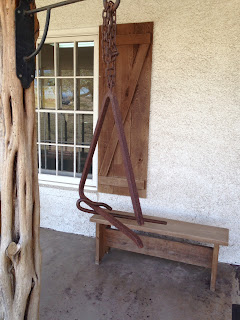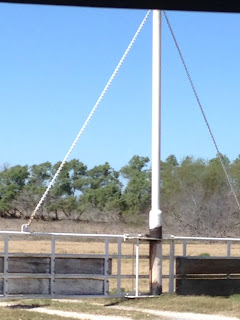First, we headed into town to the King Ranch Museum.
The museum is in a beautiful brick building with lots of ironwork on the windows and doors. It was a good place to start because it dealt with the history of the King Ranch and its legacy. Unfortunately, I couldn't take any pictures in the museum.
A BRIEF BIO & SOME INTERESTING FACTS
* Richard King was born in New York City & was indentured to a jeweler as a young boy. He hated it and ran off to sea, where he worked his way up through the ranks and became a captain. When his good friend and fellow riverboat captain, Mifflin Kenedy, contacted him with a job offer taking supplies up & down the Rio Grande River, he came to Texas. He began buying up land around the Santa Getrudis Creek to establish a cattle ranch. The Santa Getrudis Ranch was established in 1853.
Captain King was married to Henrietta and they had five children. Their son in law, Bob Kleberg, was instrumental in helping to run the ranch, especially after Richard's death in 1885.
*At its largest, the King Ranch was comprised of 1.2 million acres
*The King Ranch is also involved in cotton & milo farming, oil, hardware, citrus groves, sod farms, pecan groves, saddle making and Ford trucks
*The King Ranch has developed 2 breeds of cattle - the Santa Gertrudis & the Santa Clara
*The King Ranch were one of the first Quarter horse breeders and their stallion, Whimpy P1, is entry #1 in the Quarter horse registry.
*The King Ranch also bred racing Thoroughbreds, including 1946 Triple Crown winner, Asault.
The museum had a lot of pictures of the original interior of the main house, and some very cool old photos of ranching taken way back. They had some of the original drawings for the Tiffany Stained Glass windows in the house, and some of the wicker furniture that Tiffany also designed. The saddle collection was beautiful, too, but my favorite was the automobile designed to be driven around the ranch.
I was able to find this photo of it online. It had a heavy duty frame and springs so it could be driven over the rocky ground. There are rifles stored at the reach of the driver and passenger, and under them is a compartment for ammo. On the hood, over each headlight is a cradle for game, or you can put a seat on it so you can ride on the hood and shoot. In the back seat, there is a fold down bar with room for everything.
Next, we headed out to the King Ranch Visitor Center to go on tour of the ranch itself.
The visitor's center was in quite the cool building, very ranch-like!
This was a neat sign about the Quarter horses bred on the ranch.
The dinner bell.
Since the ranch is so large, we boarded a bus & our driver, Carl, took us on about a 10 mile tour. He was fantastic.
The longhorns were enjoying the sun.
These are the Santa Gertrudis. They were developed breeding Brahma to Scottish Shorthorns - 3/8 Brahma-5/8 Shorthorn. They are a deep red, big, muscly cattle - our driver says they are delicious (he also said longhorns are like chewing shoe leather).
Lots of pastures with horses. They are all either bay or sorrel.
The Ranch House from across the pasture. This is the third house on this spot. The first was just a small shack, then a small house that was added on to as more children came. When it burned down, Henrietta & Robert Kleberg planned and built this new huge house. Many members of the family lived there and relatives still use the house today.
There are tons of birds & wildlife on the ranch. This was a white breasted hawk.
Here are two javelinas. We saw a lot of them - some huge groups with babies.
Didn't see any of these!
This old silo was made out of glazed ceramic tile!
One of many "swing gates". Carl said they were designed by engineers who were too lazy to get out to open and close the gates. You drive up and bump the gate and it swings around and closes behind you.
One of the original buildings from the day when it was the Santa Gertrudis Ranch.
A row of one of the many brick stables.
Houses where the ranch hands could live (and some still do).
The grounds of the main house and the main house.
We weren't allowed to stop at the main house, so excuse these photos - I had to take them on the fly.
One of the highlights of our tour was the chance to visit with "Lolo", a fifth generation ranch hand at King Ranch. He was 79 years old, and just as spry as can be. He told us about being one of the first to ride the Thoroughbred, Assault, and what a cattle roundup was like.
Lolo was a descendant of the original ranch hands, Mexicans who left their village to come and work on Captain King's cattle ranch. They were called Kinenos - King's men.
One of the things Lolo showed us was this loom, where the saddle blankets were made. He also talked about the brands on the cattle and the horses. King Ranch is know by its running W brand. No one really seems to know why Captain King chose that brand - but it is on everything. We stopped at the King Ranch Saddle Shop in town, and believe me, you can find it on everything. The saddle shop is full of all kinds of western doo dads, beautiful clothing, jewelry, cowboy boots, and some of the coolest furniture & accessories ever.
We also took a trip to the town of Sarita, where the Kenedy Ranch Museum is located. Mifflin Kenedy and Richard King remained friends all their lives, and this little museum is a wonderful visual depiction of early Texas and the ranchers.
The Kenedy Land Company building houses the museum.
These colorful murals tell the story of Kenedy and south Texas.
The numbers under the mural were for the audio device that told us about the history, so we didn't have to read everything!
There were also these lifelike sculptures of the Kenedy family and their workers.
Ranch hands & family.
Kenedy in his office.
The vault door
This is the Kenedy's daughter, Sarita, who loved the ranch and everything to do with it.
Sarita as an adult - isn't she beautiful?
Mifflin and his wife only had two children - and due to illnesses, both of them were sterile. Sarita & her husband contracted and influenza that made them both sterile & her brother had mumps as an adult. Because there was no one to inherit the estate, Sarita the majority of it to the church.
This is a statue of Brother Leo, who was the monk who was an advisor to Sarita.


































No comments:
Post a Comment